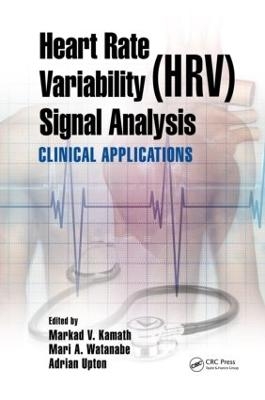
Heart Rate Variability (HRV) Signal Analysis
Crc Press Inc (Verlag)
978-1-4398-4980-4 (ISBN)
Quantifying the amount of autonomic nervous system activity in an individual patient can be extremely important, because it provides a gauge of disease severity in a large number of diseases. Heart rate variability (HRV) calculated from both short-term and longer-term electrocardiograms is an ideal window into such autonomic activity for two reasons: one, heart rate is sensitive to autonomic activity in the entire body, and two, recording electrocardiograms is inexpensive and non-invasive unlike other techniques currently available for autonomic assessment, such as microneurography and metaiodobenzylguanidine (MIBG) scanning. Heart Rate Variability (HRV) Signal Analysis: Clinical Applications provides a comprehensive review of three major aspects of HRV: mechanism, technique, and clinical applications.
Learn Techniques for HRV Signal Analysis
Edited by an engineer, a cardiologist, and a neurologist, and featuring contributions by widely published international researchers, this interdisciplinary book begins by reviewing the many signal processing techniques developed to extract autonomic activity information embedded in heart-rate records. The classical time and frequency domain measures, baroreceptor sensitivity, and newer non-linear measures of HRV are described with a fair amount of mathematical detail with the biomedical engineer and mathematically oriented physician in mind. The book also covers two recent HRV methods, heart-rate turbulence and phase-rectified signal averaging.
Use of HRV in Clinical Care
The large clinical section is a must-read for clinicians and engineers wishing to get an insight into how HRV is applied in medicine. Nineteen chapters altogether are devoted to uses of HRV in:
Monitoring—for example to predict potential complications in pregnancies, fetal distress, and in neonatal critical care
Acute care—for gauging the depth of anesthesia during surgery and predicting change in patient status in the intensive care unit
Chronic disorders—for assessing the severity of congestive heart failure, stroke, Parkinson’s disease, and depression
Bringing together the latest research, this comprehensive reference demonstrates the utility and potential of HRV signal analysis in both the clinic and physiology laboratory.
Markad V. Kamath, Ph.D. is a professor in the department of Medicine, with associate memberships in the Computing and Software Engineering and Electrical and Computer Engineering departments at McMaster University, Hamilton, Ontario, Canada. He received a B.Eng. from Karnataka Regional Engineering College (now the National Institute of Technology), India, a Ph.D. in biomedical engineering from the Indian Institute of Technology (Madras), and a Ph.D. in medical sciences from McMaster University. He is the editor of the journals Critical Reviews in Biomedical Engineering and Critical Reviews in Physical and Rehabilitation Medicine and the founding editor of Visualization, Image Processing and Computation in Biomedicine. He is a registered professional engineer in the province of Ontario, Canada. Mari A. Watanabe, M.D., Ph.D., is currently an assistant professor in the cardiology department at St. Louis University. She received her M.D. from Nippon Medical School in Tokyo and Ph.D. in physiology and applied mathematics from Cornell University. She has conducted research in cardiology, mathematics and physics at various institutions, including the University of Pennsylvania, Beth Israel Deaconess Medical Center in Boston, University of Utah, and Glasgow University in Scotland. She has received research grants from the American Heart Association, National Institute of Health and British Heart Foundation. She publishes papers in both clinical and basic science journals. Adrian R.M. Upton, M.D., FRCP(C), FRCP(E), FRCP(G), is a professor of medicine at McMaster University. Dr. Upton qualified as a physician in the United Kingdom and has held a number of senior positions, including the director of the neurology department and director of the Diagnostic Neurophysiology Laboratory at Chedoke-McMaster hospitals, Canada. He has published over 400 papers in areas such as autonomic stimulation, evoked potentials, electroencephalography and electromyography, among others. He has also trained many student physicians, residents, graduate students, and post-doctoral fellows. He holds 12 patents.
Heart Rate Variability: A Historical Perspective. Section I Heart Rate Variability Techniques: Methodological Aspects of Heart Rate Variability Analysis. Methodological Aspects of Baroreflex Sensitivity Analysis. Arterial Blood Pressure Waveform Analysis and Its Applications in the Assessment of Vasovagal Syncope. Heart Rate Turbulence. Phase-Rectified Signal Averaging: Methods and Clinical Applications. Section II Clinical Applications of Heart Rate Variability—Monitoring: Heart Rate Variability Analysis for the Monitoring of Fetal Distress and Neonatal Critical Care. Heart Rate Variability and Blood Pressure Variability in Obstetrics and Gynecology. Effects of Exercise Training on Heart Rate Variability in Patients with Hypertension. Heart Rate Variability and Sleep. Section III Clinical Applications of Heart Rate Variability—Acute Care: Heart Rate Variability in the Intensive Care Unit. Heart Rate Variability and Cardiovascular Dynamic Changes during Local Anesthesia. Effect of General Anesthesia on Heart Rate Variability. Heart Rate Variability in Functional Neurosurgery. Bariatric Surgery and Its Effects on Heart Rate Variability. Section IV Clinical Applications of Heart Rate Variability—Chronic Disorders: Heart Rate Variability in Congestive Heart Failure. Heart Rate Variability Analysis in Ischemic Cardiomyopathy and Aortic Stenosis Patients. Heart Rate Variability and Blood Pressure Variability in Respiratory Disease: Effects of Pharmaceutical Compounds, Non-Invasive Ventilation and Physical Exercise. Effects of Spinal Cord Injury on Heart Rate Variability and Blood Pressure Variability. Autonomic Dysfunction in Stroke. The Significance of Heart Rate Variability in Patients with Epilepsy. Classification of Parkinson’s Disease Severity Using Heart Rate Variability Analysis. Heart Rate Variability in Neuropsychiatric Disorders. Heart Rate Variability and Depression. Heart Rate Variability as a Measure of Depression and Anxiety during Pregnancy. Index.
| Zusatzinfo | 44 Tables, black and white; 110 Illustrations, black and white |
|---|---|
| Verlagsort | Bosa Roca |
| Sprache | englisch |
| Maße | 178 x 254 mm |
| Gewicht | 1133 g |
| Themenwelt | Medizinische Fachgebiete ► Innere Medizin ► Kardiologie / Angiologie |
| Medizin / Pharmazie ► Physiotherapie / Ergotherapie ► Orthopädie | |
| Technik ► Elektrotechnik / Energietechnik | |
| Technik ► Medizintechnik | |
| Technik ► Umwelttechnik / Biotechnologie | |
| ISBN-10 | 1-4398-4980-3 / 1439849803 |
| ISBN-13 | 978-1-4398-4980-4 / 9781439849804 |
| Zustand | Neuware |
| Haben Sie eine Frage zum Produkt? |
aus dem Bereich


